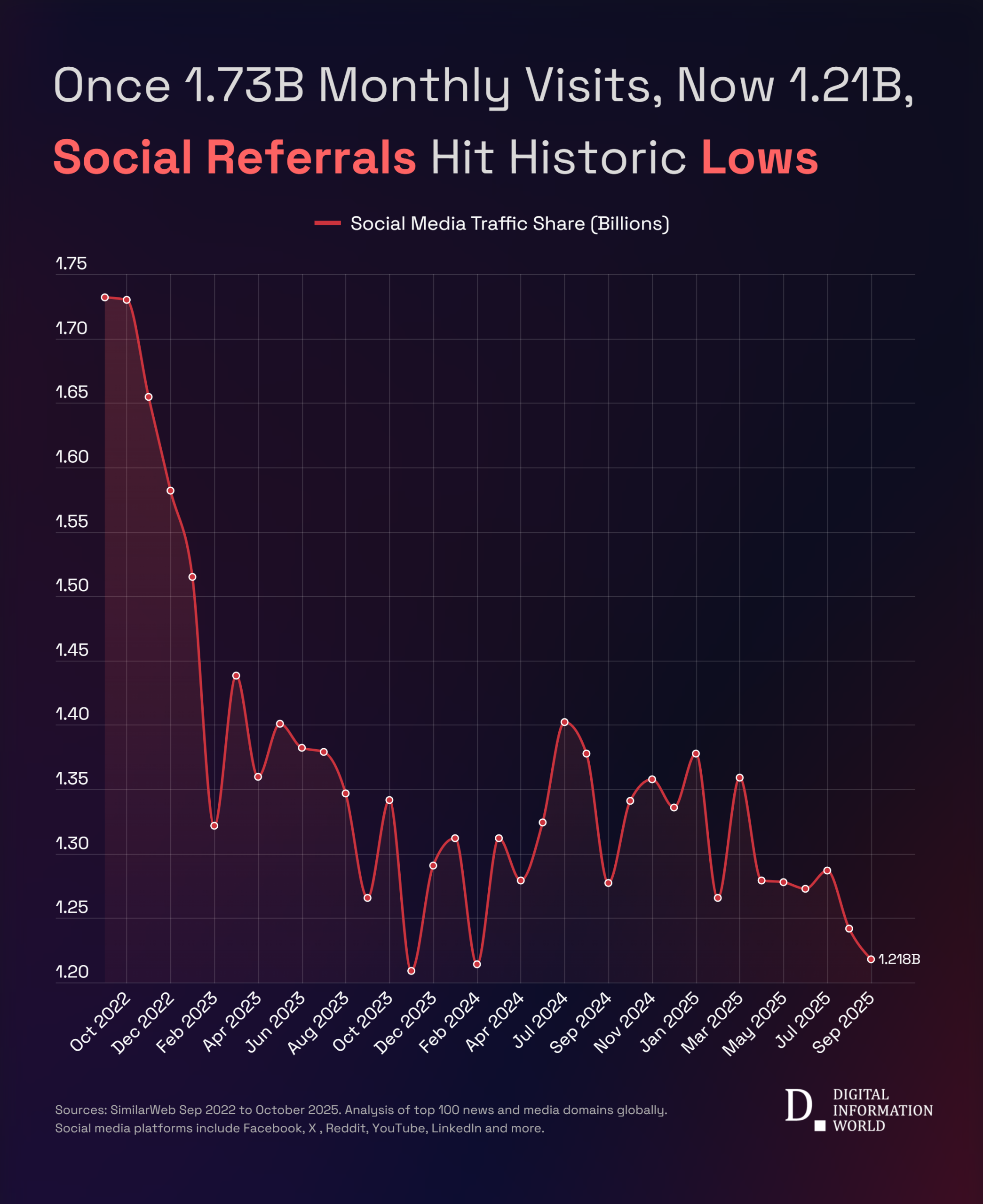Over the past three years, social networks have sent far fewer readers to news sites. Data from Similarweb shows that referrals to the top 100 global media domains peaked at roughly 1.75 billion in late 2022 and now hover near 1.22 billion. The decline, close to thirty percent, highlights how the relationship between news organizations and social networks has weakened as the latter move toward formats and tactics that keep users inside their own apps.
Through 2023 and 2024, the drop remained steady. Monthly traffic slipped almost every quarter, with only brief recoveries when new features surfaced or algorithms shifted. By mid-2025, the figure settled around 1.24 billion, showing no sign of returning to earlier levels.
A major factor lies in how platforms now treat external links. The rise of short videos on Facebook, Instagram, and YouTube has reshaped what people see in their feeds. Posts that open external sites compete poorly with clips that keep audiences watching within the same app. LinkedIn and X have also reduced the visibility of outbound links, encouraging interactions that stay on the platform rather than sending users elsewhere.
Some networks are testing small adjustments to reverse the slide. X has begun experimenting with a new link format on iOS that allows users to react to posts while browsing external pages, hoping to make link engagement feel less detached. Instagram is also trying clickable link options inside posts, which could make it easier for creators to direct followers to their own sites.
For news publishers, the loss is significant. Many built their distribution strategies on the traffic once supplied by Facebook or Twitter. As those pathways shrink, even the biggest outlets face lower referral volumes and weaker advertising returns tied to that audience flow. Smaller publishers, which relied heavily on social referrals, feel the impact more sharply.
In response, a new niche has grown around link-in-bio tools like Linktree and Beacons. These services help creators and brands guide followers to other destinations, but their benefits to newsrooms remain limited. While they provide an alternative route to external content, they cannot restore the consistent stream of readers that traditional social referrals once delivered. The trend suggests a lasting shift in how people encounter news online. With platforms prioritizing video and in-app activity, links to independent outlets are becoming a secondary pathway rather than the main entry point to information.d engagement loops, the open web feels more distant from where people spend their time online.
| Month/Year | Social Traffic Share (Billions) |
|---|---|
| Sep 2022 | 1.732B |
| Oct 2022 | 1.730B |
| Nov 2022 | 1.655B |
| Dec 2022 | 1.582B |
| Jan 2023 | 1.515B |
| Feb 2023 | 1.322B |
| Mar 2023 | 1.438B |
| Apr 2023 | 1.360B |
| May 2023 | 1.401B |
| Jun 2023 | 1.382B |
| Jul 2023 | 1.379B |
| Aug 2023 | 1.347B |
| Sep 2023 | 1.266B |
| Oct 2023 | 1.342B |
| Nov 2023 | 1.209B |
| Dec 2023 | 1.291B |
| Jan 2024 | 1.312B |
| Feb 2024 | 1.214B |
| Mar 2024 | 1.312B |
| Apr 2024 | 1.279B |
| May 2024 | 1.324B |
| Jul 2024 | 1.402B |
| Aug 2024 | 1.378B |
| Sep 2024 | 1.277B |
| Oct 2024 | 1.341B |
| Nov 2024 | 1.358B |
| Dec 2024 | 1.336B |
| Jan 2025 | 1.378B |
| Feb 2025 | 1.266B |
| Mar 2025 | 1.359B |
| Apr 2025 | 1.279B |
| May 2025 | 1.278B |
| Jun 2025 | 1.273B |
| Jul 2025 | 1.287B |
| Aug 2025 | 1.242B |
| Sep 2025 | 1.218B |
Notes: This post was edited/created using GenAI tools. Image: DIW-Aigen.
Read next: 60% of Fortune 500 Companies Rely on AWS. What an Hour of Downtime Really Costs[1]
References
- ^ 60% of Fortune 500 Companies Rely on AWS. What an Hour of Downtime Really Costs (www.digitalinformationworld.com)

